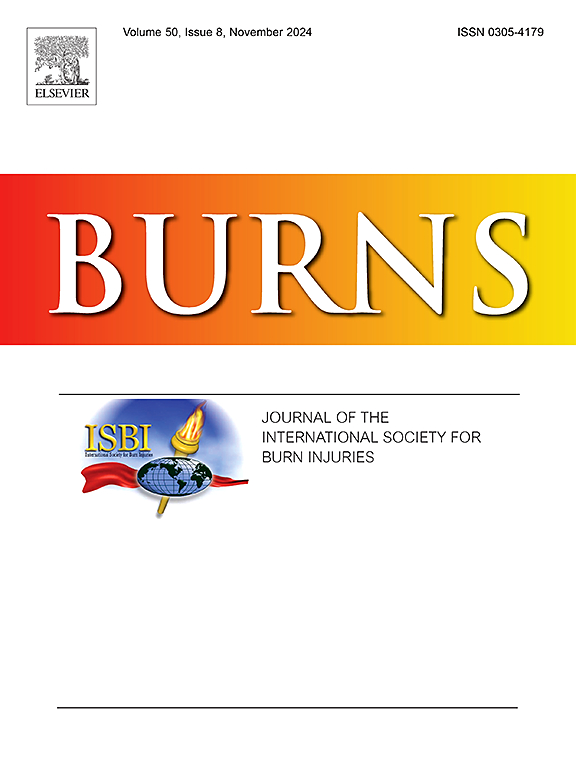Efficacy of biomaterials in burn treatment: Comparative study of collagen-derived membranes, hydrogel, and sponge in an animal model
IF 3.2
3区 医学
Q2 CRITICAL CARE MEDICINE
引用次数: 0
Abstract
Purpose
Thermal burns are complex injuries that significantly impact morbidity and mortality. This study aimed to evaluate the effectiveness of biomaterials, including collagen gel (CG), collagen sponge (CS), non-decellularized amniotic membrane (NAM), and decellularized amniotic membrane (DAM), in promoting wound healing in a rat burn model.
Methods
Sixty Wistar rats were divided into five groups: control, CG, CS, NAM, and DAM. Burn wounds were induced using a heated metal rod, and treatments were applied accordingly. Histological and macroscopic analyses were conducted on days 7 and 14 post-burn to assess inflammation, proliferation of collagen fibers, angiogenesis, and re-epithelialization. Statistical comparisons of wound healing parameters were performed.
Results
By day 7, the CS group showed significant fibroblast proliferation and collagen deposition, facilitating early-stage healing. However, the NAM group demonstrated superior angiogenesis and granulation tissue formation by day 14, with advanced dermal matrix organization and nearly complete epithelialization, including hair regrowth. DAM exhibited moderate proliferation of collagen fibers and angiogenesis but lagged NAM in epidermal regeneration. CG promoted re-epithelialization and vascular remodeling but was less effective than NAM. The control group showed delayed healing with limited repair markers. Overall, NAM was the most effective biomaterial, followed by CG, CS, and DAM.
Conclusion
NAM emerged as the optimal treatment for burn healing, demonstrating superior efficacy in promoting angiogenesis, collagen organization, and epithelial regeneration. These findings underscore the potential of biological membranes in improving burn outcomes. Further human studies are warranted to validate these results and explore clinical applications.
生物材料在烧伤治疗中的疗效:胶原源膜、水凝胶和海绵在动物模型中的比较研究
目的热烧伤是影响发病率和死亡率的复杂损伤。本研究旨在评价胶原凝胶(CG)、胶原海绵(CS)、非脱细胞羊膜(NAM)和脱细胞羊膜(DAM)等生物材料对大鼠烧伤模型创面愈合的促进作用。方法Wistar大鼠60只,随机分为对照组、CG组、CS组、NAM组和DAM组。用加热的金属棒诱导烧伤创面,并进行相应的治疗。在烧伤后第7天和第14天进行组织学和宏观分析,以评估炎症、胶原纤维增殖、血管生成和再上皮化。对创面愈合参数进行统计学比较。结果第7天,CS组成纤维细胞增殖明显,胶原沉积明显,有利于早期愈合。然而,NAM组在第14天表现出优越的血管生成和肉芽组织形成,真皮基质组织先进,上皮化几乎完全,包括毛发再生。DAM表现出适度的胶原纤维增殖和血管生成,但在表皮再生方面落后于NAM。CG促进再上皮化和血管重构,但效果不如NAM。对照组出现愈合延迟,修复标记物有限。总的来说,NAM是最有效的生物材料,其次是CG、CS和DAM。结论nam在促进血管生成、胶原组织和上皮细胞再生方面具有显著的促进作用,是烧伤愈合的最佳治疗方法。这些发现强调了生物膜在改善烧伤结果方面的潜力。需要进一步的人体研究来验证这些结果并探索临床应用。
本文章由计算机程序翻译,如有差异,请以英文原文为准。
求助全文
约1分钟内获得全文
求助全文
来源期刊

Burns
医学-皮肤病学
CiteScore
4.50
自引率
18.50%
发文量
304
审稿时长
72 days
期刊介绍:
Burns aims to foster the exchange of information among all engaged in preventing and treating the effects of burns. The journal focuses on clinical, scientific and social aspects of these injuries and covers the prevention of the injury, the epidemiology of such injuries and all aspects of treatment including development of new techniques and technologies and verification of existing ones. Regular features include clinical and scientific papers, state of the art reviews and descriptions of burn-care in practice.
Topics covered by Burns include: the effects of smoke on man and animals, their tissues and cells; the responses to and treatment of patients and animals with chemical injuries to the skin; the biological and clinical effects of cold injuries; surgical techniques which are, or may be relevant to the treatment of burned patients during the acute or reconstructive phase following injury; well controlled laboratory studies of the effectiveness of anti-microbial agents on infection and new materials on scarring and healing; inflammatory responses to injury, effectiveness of related agents and other compounds used to modify the physiological and cellular responses to the injury; experimental studies of burns and the outcome of burn wound healing; regenerative medicine concerning the skin.
 求助内容:
求助内容: 应助结果提醒方式:
应助结果提醒方式:


